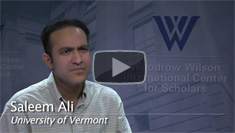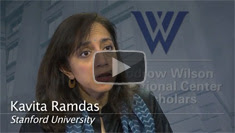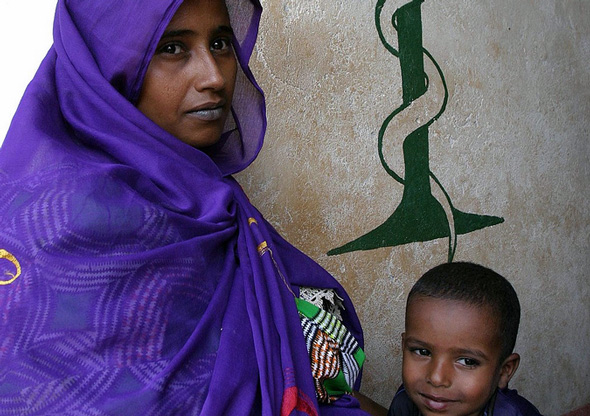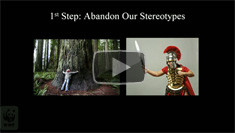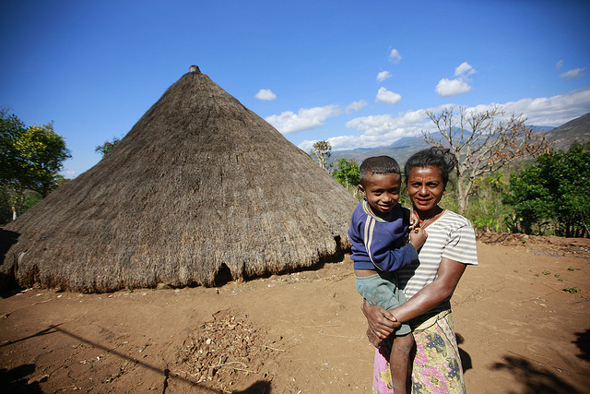-
Peacemakers or Exclusion Zones? Saleem Ali on Transboundary Peace Parks
› “Traditionally, natural resources have been thought of as a source of conflict…but what we’ve been trying to do is look at the other side of the story, which is that natural resources, in terms of their quality, can create that impulse for conservation and cooperation,” said Saleem Ali, professor of environmental studies and director of the Institute for Environmental Diplomacy and Security at the University of Vermont, while speaking at the Wilson Center.
“Traditionally, natural resources have been thought of as a source of conflict…but what we’ve been trying to do is look at the other side of the story, which is that natural resources, in terms of their quality, can create that impulse for conservation and cooperation,” said Saleem Ali, professor of environmental studies and director of the Institute for Environmental Diplomacy and Security at the University of Vermont, while speaking at the Wilson Center.
This narrative around peace parks or transboundary conservation areas that are used for peacebuilding is a relatively recent field of research, said Ali. “It’s one thing to have a protected area on a border and have cooperation between friendly parties – like the U.S. and Canada,” he said, “and it’s a totally different thing to explore this in areas where there’s a history of protracted violent conflict.”
Yet, Ali said, we have “a good institutional framework for understanding what kind of parks could potentially be developed.” Cooperation between Ecuador and Peru in the Cordillera del Condor protected area, for example, is an incidence where transboundary conservation was actually written into the peace process between two warring states. Recent tragedies on the Siachen glaciers highlight another case where calls have been made to use peace parks as a way to demilitarize a contentious border over which India and Pakistan have long argued.
Questions remain though about the capacity of conservation processes to sustain peace, and “whether micro-conflicts that might arise through any conservation being practiced can be managed effectively.” Peace parks established in South Africa after apartheid, for example, produced “micro-conflicts between the haves and the have-nots – the classic conflict between conservation as an exclusionary arena versus a more inclusionary vision.”
“A lot of those organizations have learned from those past mistakes and we’re moving in the right direction,” Ali said, “but that’s still an area that requires far more research, and also more applied work, to find the right mix of conservation and economic development.” -
One Country, Two Stories: Marc Sommers on Rwandan Youth’s Struggle for Adulthood
›Almost an entire generation of Rwandans is confronting the prospect that they are going to be failed adults, said Marc Sommers, a fellow with Woodrow Wilson Center’s Africa Program and visiting researcher at Boston University’s African Studies Center.
-
Kavita Ramdas: Why Educating Girls Is Not Enough
› “I’m a big proponent of girl’s education. I believe that it’s a very important and a very valuable human rights obligation that all countries should be meeting,” said Kavita Ramdas, executive director for programs on social entrepreneurship at Stanford University, at the Wilson Center. However, “in the past seven to eight years we have found ourselves in a situation where there’s kind of an enchantment with girl’s education, as though it were the new microenterprise magic bullet to solve everything from poverty, to malnourishment, to inequality.”
“I’m a big proponent of girl’s education. I believe that it’s a very important and a very valuable human rights obligation that all countries should be meeting,” said Kavita Ramdas, executive director for programs on social entrepreneurship at Stanford University, at the Wilson Center. However, “in the past seven to eight years we have found ourselves in a situation where there’s kind of an enchantment with girl’s education, as though it were the new microenterprise magic bullet to solve everything from poverty, to malnourishment, to inequality.”
“The outcomes that we ascribe to girl’s education…are not anything that I would argue with,” she said, yet, this enchantment “has happened simultaneously with a significant drop in both funding and support for strategies that give girls and women access to reproductive health and choices, particularly family planning.”
This is a problem, said Ramdas, because we cannot rely on education alone to do all the heavy lifting required to empower women.
“I think it’s important for us to recognize that there are societies where girls and women have achieved significantly high levels of education in which gender inequality remains,” she said, “for example, places like Japan and Saudi Arabia, where you have high per capita income, high levels of education, and yet…where women and girls are still marginalized and on the edges in terms of decision making.”
“I don’t think we have to wait for one to be able to do the other,” she said. “As we support programs for girls’ education, we also need to demand that those programs be buttressed by strong programs in adolescent health, strong programs in sex education, strong programs that actually provide girls and women with access to family planning and contraception.” -
Africa’s Demographic Challenges, Genderizing Food Security and Climate Responses
›Gender and Climate Change Research in Agriculture and Food Security for Rural Development is a detailed training guide produced by the CGIAR Research Program on Climate Change, Agriculture and Food Security and the Food and Agricultural Organization of the United Nations (FAO). The guide’s purpose is to support “work to investigate the gender dimensions of responding to climate change in the agriculture and food sectors…to improve food production, livelihood security and gender equality.” The authors write that “the number of hungry people in the world could be reduced by more than 100 million if women in rural areas were given equal access to the same resources as men.” The guide focuses on sensitizing researchers and practitioners “to the links between socio-economic and gender issues” and provides a suite of tools for gathering data about the gender and climate change aspects of agricultural development. Along with concrete tools to understand and address gender inequities in agricultural development, the report adopts a nuanced social definition of gender in which “people are born female or male, but learn to be women and men,” keeping the focus squarely on the socio-economic and political barriers to full equality.
A report from the Berlin Institute for Population and Development, Africa’s Demographic Challenges: How A Young Population Can Make Development Possible, argues that “if mortality and fertility decrease” across the African continent, there will be a “demographic bonus.” If nurtured through ample investment in human capital, this bonus may become a “demographic dividend,” as growing numbers of working-age people participate in the economy. The report argues that taking advantage of this demographic window, however, requires policy actions that both encourage fertility reductions and foster economic development throughout the continent, declaring boldly that “high birth rates and development are mutually exclusive.” Thus, according to the authors, the pathway to development is supporting the empowerment and education of women and girls, strengthening reproductive health services, and ensuring that both young women and young men are able to engage socio-economically within their societies. Though the report’s argument that demographic change can be critical for development is convincing, the form, strength, and causal direction of these linkages at times becomes confused. -
Women’s Health: Key to Climate Adaptation Strategies
›
The discussion about family planning and reproductive rights “needs to be in a place where we can talk thoughtfully about the fact that yes, more people on this planet – and we’ve just crossed seven billion – does actually put pressure on the planet. And no, it is not just black women or brown women or Chinese women who create that problem,” said Kavita Ramdas, executive director for programs on social entrepreneurship at Stanford University. [Video Below]
-
Geoff Dabelko on Finding Common Ground Among Conservation, Development, and Security at the 2011 WWF Fuller Symposium
› Bridging the divide between the conservation and security communities “requires that we check some stereotypes at the door,” said ECSP’s Geoff Dabelko at the World Wildlife Fund’s Conservation Forward: Ideas That Work and How Science Can Effect Change symposium. Changes in global climate, as well as environmental threats more local in origin, require us to “find ways to minimize threats [and] maximize opportunities…from the dialogue between these different communities – and get out of our silos to do that,” said Dabelko.
Bridging the divide between the conservation and security communities “requires that we check some stereotypes at the door,” said ECSP’s Geoff Dabelko at the World Wildlife Fund’s Conservation Forward: Ideas That Work and How Science Can Effect Change symposium. Changes in global climate, as well as environmental threats more local in origin, require us to “find ways to minimize threats [and] maximize opportunities…from the dialogue between these different communities – and get out of our silos to do that,” said Dabelko.
However, this dialogue faces real challenges and concrete trade-offs. “There are big imbalances in terms of the resources that these different communities have,” and this often cuts the conversation short, he said. The conservation and security communities are also orientated towards some very different objectives and toolsets. But “given the levels of stress that our natural systems are under, given the level of dysfunction that are political systems are exhibiting, to me, it suggests that it’s a call for all hands on deck,” asserted Dabelko.
“The relationship between environment, natural resources, and violent conflict” is not the “only part of the story,” he said. Conservation goals can be achieved by preserving biodiversity on military sites and demilitarized zones, and through the Department of Defense’s new focus on reducing energy consumption. In the past, Russian-Norwegian-U.S. cooperation around de-commissioning Soviet-era nuclear submarines protected fragile Arctic habitats, prevented potentially dangerous technology from reaching world markets, and built confidence between recent adversaries. The dual potentials of “peace parks” in fragile and insecure borders across the Middle East have also garnered attention.
Environmental Peacebuilding
“Too often…natural resources are viewed as luxury items – what you worry about once you get rich, democratic, and peaceful,” yet, the environment is an “essential ingredient” for peace, Dabelko said. It is often “key to restoring livelihoods and jump-starting the economy” in conflict affected countries.
“Under a rubric or umbrella that we’re calling ‘environmental peacebuilding’ we have systematic efforts to…break those links with conflict,” he said. The future “concern is that because of environmental change, growth in population, growth in consumption,” and rampant inequities, climate change will act as a “threat multiplier.” “A risk analysis frame” is required to think through not only the risk of failing to act but also the risk of acting in ways that have the potential to create conflict if done poorly.
“We’re talking about changing access to resources and introducing money into uncertain political contexts – who gets it for what. That can be done well and that can be done poorly, and if you are talking to the folks in the conflict community, that’s often an inflection point for when conflict is a potential,” Dabelko said. In the context of potentially troublesome adaptations such as biofuel production, hydropower projects, and REDD+, this means taking seriously the well-worn, but apt, mantra of “do no harm” and working to maximize the “triple bottom line” of development, peace, and climate stability.
A question and answer period, moderated by USAID’s Cynthia Gill, followed the presentation with fellow speakers Anne Salomon of Fraser University, Michael Jenkins of Forest Trends, and Martin Palmer from the Alliance of Religions and Conservation (available below). -
Reaching Out to Environmentalists About Population Growth and Family Planning
›“Promoting women’s empowerment is an effective strategy for looking at climate and the environment but also is important in its own right,” said the Sierra Club’s Kim Lovell at the Wilson Center on February 22. “Increasing access to family planning for women around the world is a climate adaptation and climate mitigation solution.” [Video Below] Drawing on research by Brian O’Neill (National Center for Atmospheric Research) and others Lovell explained that meeting the unmet need for family planning around the world could provide up to 16 to 29 percent of the emissions reductions required by 2050 in order to avoid more than two degrees of warming (the target set by nations to prevent the most damaging effects of climate change).
Drawing on research by Brian O’Neill (National Center for Atmospheric Research) and others Lovell explained that meeting the unmet need for family planning around the world could provide up to 16 to 29 percent of the emissions reductions required by 2050 in order to avoid more than two degrees of warming (the target set by nations to prevent the most damaging effects of climate change).
For environmentalists and those concerned with climate change, “sometimes the idea has been that population is toxic, that we can’t talk about population growth,” said Nancy Belden of Belden Russonello and Stewart Consulting, but the results of a recent survey and several focus groups conducted in association with Americans for UNFPA demonstrate that there is great potential for engaging the environmental community in such a discussion.
Belden and Lovell were joined by Kate Sheppard from Mother Jones to discuss how the population and environment communities can come together in the lead-up to the Rio+20 UN sustainable development conference.
Besides providing a basic health commodity, empowering women through access to family planning also improves adaptation outcomes, said Lovell. “Climate change is already happening and women and families around the world are suffering from the effects of water scarcity [and] of erratic weather patterns,” she said. But “when women have the ability to plan their family size and have more choices about their families and about their reproductive health and rights, that makes it easier to adapt to those climate change effects that are already taking place.”
Resonating With Environmental Priorities
“The people who really care about the environment are generally the same people who care about access to contraception and birth control and family planning…they’re a ready audience to hear about these connections and they’re a ready audience to take action about them,” said Kate Sheppard. Reproductive rights issues are something that people can really connect with, she said; “most women, most men too…understand why it’s an important issue and they’ve understood it in their own life and they have [a] very strong response to it.”
When we approach the linkages between environment and population, said Sheppard, it is important to recognize the role of empowering language – language about access to services, education, and resources for women.
The aim of the Americans for UNFPA survey was to find out whether environmentalists can be engaged in discussions of population issues such as family planning and international voluntary contraception, and if so, how?
The results show that “environmentalists are ready to talk about population, they’re ready to listen – it’s not toxic,” said Belden. She outlined three key findings:
First, environmentalists prioritize the environment but they also give a high priority to empowering women, said Belden. “Population pressures are seen as an environmental problem…they don’t dismiss it,” yet the “strongest framework that we could come up with…for engaging people on the issues around voluntary family planning and contraception focuses on women.”
Second, the environmental community is relatively optimistic about the potential outcomes of family planning programs and of foreign aid in general. When queried, half of the environmentalists strongly supported the idea of U.S. contributions to UN programs that provide voluntary access to contraception in developing countries, said Belden.
When asked to mark their top priority among a list of possible outcomes of providing voluntary access to contraception, 47 percent of the environmentalists selected either “improving living conditions for women and their families” or “ensuring women have options and can make reproductive decisions” as their top priority. While a significant number are also concerned about stalling population growth, this integrative focus on improving the lives of women and their families is heartening, said Belden.
In the Run-Up to Rio+20, More Than Pop
One point that all three speakers stressed is the need to integrate consumption into the integrated population message. In her survey work, Belden found that “if you don’t talk about consumption in the same breath, [environmentalists] start wanting to put it in there because otherwise…this is someone blaming others.”
Lovell similarly highlighted that “if we’re working to ensure a sustainable planet for future generations to come, we have to think about consumption and population.” For instance, “the United States makes up five percent of the world’s population but consumes 25 percent of the world’s resources,” she said.
Said Sheppard: “It’s not simply a problem that the numbers of people here on the Earth are going up, it’s a problem of how people, especially here in the U.S., live.”
It is imperative – especially from a sustainable development standpoint – that while working towards integrating environment and population we remain focused on a message that includes “using less but still having a high quality of life” here at home, said Sheppard.
Event ResourcesSources: Proceedings of the National Academy of Sciences.
Photo Credit: “Timorese Traditional Home,” courtesy of United Nations Photo. -
USAID’s Donald Steinberg on Futures Analysis for International Development
›February 28, 2012 // By Stuart Kent Just as the science fiction writer Isaac Asimov explored the idea of predicting the future to influence the world towards a more prosperous, democratic, and peaceful track, so too must USAID try to better understand the challenges of tomorrow, said Donald Steinberg, deputy administrator for the U.S. Agency for International Development, during an address at USAID’s “Future of Development” symposium at the Wilson Center late last year. “Development now is too important to the United States to be left to actions that occur over 1, or 2, or 5, or even 10 years,” he continued. Looking beyond budgetary cycles, Steinberg asserted that “we have to prepare for future development patterns” by analyzing the present.
Just as the science fiction writer Isaac Asimov explored the idea of predicting the future to influence the world towards a more prosperous, democratic, and peaceful track, so too must USAID try to better understand the challenges of tomorrow, said Donald Steinberg, deputy administrator for the U.S. Agency for International Development, during an address at USAID’s “Future of Development” symposium at the Wilson Center late last year. “Development now is too important to the United States to be left to actions that occur over 1, or 2, or 5, or even 10 years,” he continued. Looking beyond budgetary cycles, Steinberg asserted that “we have to prepare for future development patterns” by analyzing the present.
Why Aid Matters
Drawing on the President’s remarks during the UN’s 2010 Millennium Development Goals Summit in New York, Steinberg outlined three reasons why development aid is central to U.S. foreign policy.
First, we all stand to benefit from living “in a world that’s peaceful, that’s democratic, that’s prosperous, that’s respectful of human rights and respectful of human dignity,” he argued.
Second, “a world that is developing is in our economic interest,” he said. “Developing nations are our fastest growing markets abroad,” providing lucrative outlets for U.S. trade and investment. Eighty-five percent of new U.S. exports over the next two decades will find their way to recipients of U.S. foreign aid, he said.
Third, aid impacts national security. Countries that are developing and prospering “don’t spew out large numbers of refugees across borders or across oceans,” he said, “they don’t transmit pandemic diseases, they don’t harbor terrorists, or now even pirates” – in short, “they don’t require American forces.”
Looking to the Future
According to Steinberg, we can take hold of the future by being prepared to grasp opportunities, even if they come in the midst of challenges.
“We’re seeing demographic shifts that are complicating once steady development patterns,” he said, “and we’re seeing more uneven distribution of wealth within countries and between countries.” But “maternal and infant mortality have plummeted [and] literacy rates are skyrocketing.”
“We still see rampant corruption and we still see crackdowns on civil society all around the world,” however Steinberg pointed out that 17 new democracies have emerged in Africa in the last 15 years alone.
On climate change, he drew from recent events in the Horn of Africa. “A changing rain pattern – from a drought every 10 years to what is now basically a drought every year – has brought together a perfect storm of famine, war, and drought,” he said. Yet across the border from Somalia, the situation is markedly different – in part because “USAID has had the capability to work with eight million Ethiopians over the past decade to strengthen their resiliency.”
Each of these shows the opportunity for positive change amidst difficult challenges, if we are prepared.
“We went through a period where we had eliminated our office of policy and planning,” said Steinberg, but over the last few years the newly established Policy, Planning, and Learning Bureau at USAID has brought back an emphasis on futures analysis. “We are now seeking to become…the thought leader in the development field,” he said.
Overall, the total amount of official government aid is small compared to other sources from the United States, said Steinberg – around $30 billion a year (compared to $36 billion in private giving, $100 billion in remittance flows, and $1 trillion in private capital flows). To make the most of that, USAID should be “a catalyst for development,” he said, working in partnership, encouraging technological innovation, and advancing cross-sectoral understanding.
“We at AID like to think in terms of budget cycles,” said Steinberg. “We’re starting to think about fiscal year [20]14, but I want you to start thinking about fiscal year 25 and fiscal year 30. I won’t challenge you to think 30,000 years ahead like Isaac Asimov did, but I think we do have to consider what the lessons of today are teaching us about the future.”
Sources: The White House.
Showing posts by Stuart Kent.


